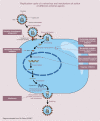Efficacy of antiviral chemotherapy for retrovirus-infected cats: What does the current literature tell us?
- PMID: 26486979
- PMCID: PMC10816252
- DOI: 10.1177/1098612X15610676
Efficacy of antiviral chemotherapy for retrovirus-infected cats: What does the current literature tell us?
Abstract
Global importance: The two feline retroviruses, feline immunodeficiency virus (FIV) and feline leukaemia virus (FeLV), are global and widespread, but differ in their potential to cause disease.
Viral infection - fiv: FIV, a lentivirus that shares many properties with human immunodeficiency virus (HIV), can cause an acquired immune deficiency syndrome, which predisposes cats to other infections, stomatitis, neurological disorders and tumours. Although secondary infections are common, specific opportunistic infections or acquired immunodeficiency virus-defining infections, such as those that occur with HIV, are not commonly reported in FIV-infected cats. In most naturally infected cats, FIV does not cause a severe clinical syndrome; with appropriate care, FIV-infected cats can live many years before succumbing to conditions unrelated to their FIV infection. Thus, overall survival time is not necessarily shorter than in uninfected cats, and quality of life is usually high over many years or lifelong.
Viral infection - felv: FeLV, an oncornavirus, is more pathogenic than FIV. Historically, it was considered to account for more disease-related deaths and clinical syndromes in cats than any other infectious agent. Recently, the prevalence and importance of FeLV have been decreasing, mainly because of testing and eradication programmes and the use of FeLV vaccines. Progressive FeLV infection can cause tumours, bone marrow suppression and immunosuppression, as well as neurological and other disorders, and leads to a decrease in life expectancy. However, with appropriate care, many FeLV-infected cats can also live several years with a good quality of life.
Practical relevance: A decision regarding treatment or euthanasia should never be based solely on the presence or absence of a retrovirus infection. Antiviral chemotherapy is of increasing interest in veterinary medicine, but is still not used commonly.
Evidence base: This article reviews the current literature on antiviral chemotherapy in retrovirus-infected cats, focusing on drugs that are currently available on the market and, thus, could potentially be used in cats.
© The Author(s) 2015.
Conflict of interest statement
The author declared no potential conflicts of interest with respect to the research, authorship, and/or publication of this article.
Figures









Similar articles
-
2008 American Association of Feline Practitioners' feline retrovirus management guidelines.J Feline Med Surg. 2008 Jul;10(3):300-16. doi: 10.1016/j.jfms.2008.03.002. Epub 2008 May 2. J Feline Med Surg. 2008. PMID: 18455463 Free PMC article.
-
Clinical aspects of feline retroviruses: a review.Viruses. 2012 Oct 31;4(11):2684-710. doi: 10.3390/v4112684. Viruses. 2012. PMID: 23202500 Free PMC article. Review.
-
Clinical aspects of feline immunodeficiency and feline leukemia virus infection.Vet Immunol Immunopathol. 2011 Oct 15;143(3-4):190-201. doi: 10.1016/j.vetimm.2011.06.003. Epub 2011 Jul 21. Vet Immunol Immunopathol. 2011. PMID: 21807418 Free PMC article. Review.
-
Feline immunodeficiency. ABCD guidelines on prevention and management.J Feline Med Surg. 2009 Jul;11(7):575-84. doi: 10.1016/j.jfms.2009.05.006. J Feline Med Surg. 2009. PMID: 19481037 Free PMC article. Review.
-
Diagnosing feline immunodeficiency virus (FIV) and feline leukaemia virus (FeLV) infection: an update for clinicians.Aust Vet J. 2019 Mar;97(3):47-55. doi: 10.1111/avj.12781. Aust Vet J. 2019. PMID: 30809813 Review.
Cited by
-
2020 AAFP Feline Retrovirus Testing and Management Guidelines.J Feline Med Surg. 2020 Jan;22(1):5-30. doi: 10.1177/1098612X19895940. J Feline Med Surg. 2020. PMID: 31916872 Free PMC article.
-
Efficacy and safety of the nucleoside analog GS-441524 for treatment of cats with naturally occurring feline infectious peritonitis.J Feline Med Surg. 2019 Apr;21(4):271-281. doi: 10.1177/1098612X19825701. Epub 2019 Feb 13. J Feline Med Surg. 2019. PMID: 30755068 Free PMC article.
-
Therapeutic and Prophylactic Use of Oral, Low-Dose IFNs in Species of Veterinary Interest: Back to the Future.Vet Sci. 2021 Jun 11;8(6):109. doi: 10.3390/vetsci8060109. Vet Sci. 2021. PMID: 34208413 Free PMC article. Review.
-
Utilizing Feline Lentiviral Infection to Establish a Translational Model for COVID-19 in People with Human Immunodeficiency Virus Infection.Microorganisms. 2024 Jun 25;12(7):1289. doi: 10.3390/microorganisms12071289. Microorganisms. 2024. PMID: 39065058 Free PMC article.
-
BET Inhibitor JQ1 Attenuates Feline Leukemia Virus DNA, Provirus, and Antigen Production in Domestic Cat Cell Lines.Viruses. 2023 Aug 31;15(9):1853. doi: 10.3390/v15091853. Viruses. 2023. PMID: 37766260 Free PMC article.
References
-
- Sellon RK, Hartmann K. Feline immunodeficiency virus infection. In: Greene CE. (ed). Infectious diseases of the dog and cat. 4th ed. St Louis, MO: Elsevier Saunders, 2012, pp 136–149.
-
- Hartmann K. Antiviral and immunomodulatory chemotherapy. In: Greene CE. (ed). Infectious diseases of the dog and cat. 4th ed. St Louis, MO: Elsevier Saunders, 2012, pp 10–24.
-
- Hartmann K. Feline leukemia virus infection. In: Greene CE. (ed). Infectious diseases of the dog and cat. 4th ed. St Louis, MO: Elsevier Saunders, 2012, pp 108–136.
Publication types
MeSH terms
Substances
LinkOut - more resources
Full Text Sources
Medical
Miscellaneous

